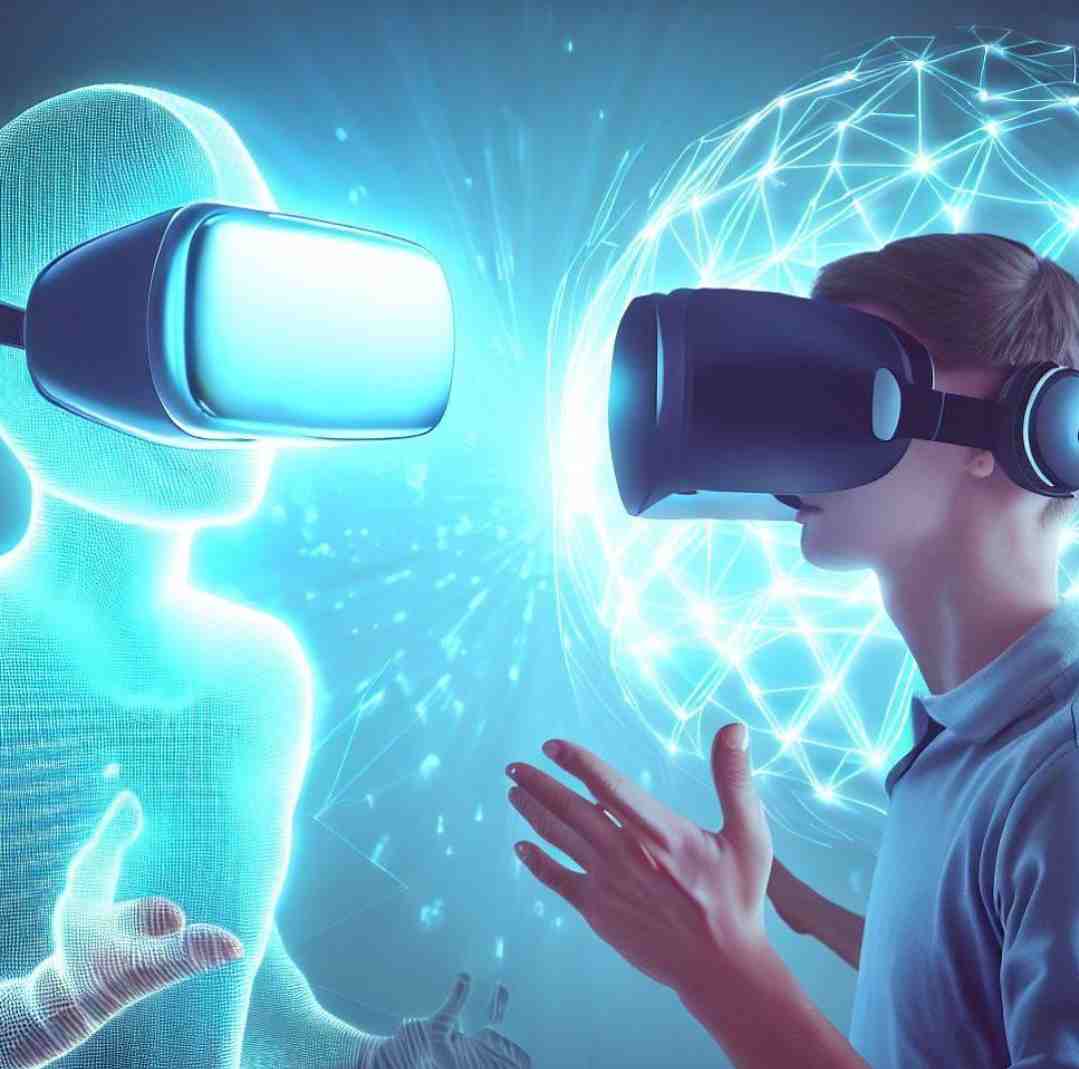Introduction:
Recent years have seen a paradigm shift in education due to the quick development of technology. The growth of virtual reality (VR) is among the most encouraging trends in this area. Beyond its gaming roots, this immersive technology has found significant uses in education. VR offers a distinctive platform for immersive learning by simulating a setting and encouraging engagement, comprehension, and retention. This essay explores the rapidly developing field of virtual reality and explores how it can revolutionize the educational landscape.
Understanding Virtual Reality (VR):
An immersive technology called virtual reality (VR) produces a simulated environment, frequently in 3D, that users may interact with as if it were real. In order to give consumers the impression that they are physically there in the virtual environment, it seeks to provide a sense of presence. A mix of specialized hardware and software is used to do this.
1.The Rise of Virtual Reality:
Virtual reality has been a notion for many years, but recent technological developments have brought it to the forefront of several sectors, including gaming, education, healthcare, and more.
Technological Developments: The quality and realism of virtual experiences have been greatly enhanced by the quick development of processing power, graphic capabilities, and motion tracking technology.
Affordable Hardware: Consumers and businesses alike now have easier access to VR technology because to the emergence of more affordable VR hardware, like as headsets and controllers.
Numerous Uses: Virtual reality (VR) has a wide range of uses outside of gaming, including training simulations, rehabilitation, architectural design, education, and healthcare.
2.History of Virtual Reality:
The concept of virtual reality can be traced back to the mid-20th century:
1950s – Sensorama: In the 1950s, American cinematographer Morton Heilig created the Sensorama, a device that provided a multi sensory movie experience. It has audio, visual, and even olfactory components to create an immersive atmosphere.
1960’s – The Sword of Damocles: The “The Sword of Damocles” head-mounted display system was created by Ivan Sutherland and his student Thomas Furness. Although it was a simple gadget, it set the stage for later advancements.
1980’s – The Virtual Reality Boom: Virtual reality had a rise in popularity in the 1980’s as firms like Atari and Nintendo investigated the first iterations of VR technology.
1990’s – Decline and Resurgence: Due to technological constraints, VR declined in the 1990’s, although this period also set the stage for further developments. As research went on, virtual reality (VR) began to resurface in the late 1990’s.
2000’s and Beyond – Modern VR: Virtual reality entered a new age with the development of more potent CPU’s, superior visuals, and user-friendly technology like the Oculus Rift and HTC Vive. This sparked the development of contemporary VR and its widespread acceptance by numerous industries.
3.Key Elements of Virtual Reality:
Head-Mounted Display (HMD): The head-mounted display, or HMD, is a headset that has displays for each eye. It offers the VR experience’s visual component.
Motion Tracking Sensors: These sensors keep track of the user’s head and body movements, enabling them to roam around and take in the virtual environment.
Input Devices: They can be full-body tracking suits, gloves, or even handheld controllers that allow users to interact with virtual items.
Immersive Audio: To give accurate spatial sound and further the immersive experience, 3D audio technology is included.
Computing Hardware: To create the intricate images and simulations required for an immersive VR experience, a powerful computer or game console is required.
Software and Content: Specialized software is used to build and render the virtual environment for VR experiences. This can include everything from simulations and games to educational software and beyond.
Understanding virtual reality’s emergence, development, and fundamental components offers a thorough understanding of this ground-breaking technology and its prospective applications in a variety of industries.
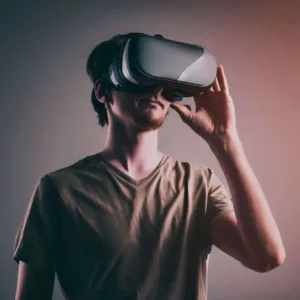
Enhancing Experiential Learning:
1.Immersive Historical Reconstructions:
Educational Significance: Students can travel back in time to see important events thanks to historical reconstructions in virtual reality, which also helps them appreciate different cultures and contexts.
Engagement: Learning becomes more interesting and remembered when historical locations are shown in three dimensions.
2.Science Simulations:
Practical Experimentation: Through the use of virtual reality, students can do experiments in secure learning environments.
Complex Concepts: It is possible to see and engage with complex scientific ideas, which improves understanding and memory.
3.Field Trips Beyond Boundaries:
Global Exploration:Beyond the boundaries of their geographic location, students can visit historical locations, cultural landmarks, and natural wonders through virtual field trips.
Diverse Learning Opportunities:Students are exposed to a variety of settings and civilizations, broadening their perspective on the world and their knowledge of other cultures.
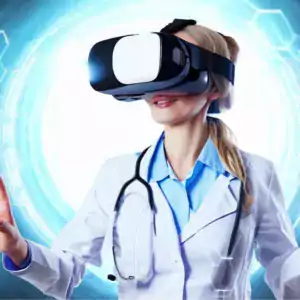
Fostering engagement and active learning:
1.Multi-Sensory Engagement:
Sensory Stimulation: With the use of VR, students are drawn in by a rich sensory experience that involves all of their senses, including sight and hearing.
Immersive Learning: The immersive nature of VR encourages exploration and engagement with virtual settings, which supports active learning.
2.Personalized Learning Journeys:
Individual Pace: It is possible for students to learn at their own pace while reviewing earlier concepts or acquiring more complex content.
Adaptive Content: The learning experience can be customized to a student’s needs using VR platforms that can alter information based on their performance and growth.
3.Increased Interactivity:
Hands-On Learning: Students can control items, work out problems, and engage with peers in VR environments, which fosters critical thinking and problem-solving abilities.
Real-Time Feedback: The learning process is improved by the immediate feedback provided by VR settings, which enables iterative learning and misperception correction.

Inclusivity and Accessibility:
1.Accommodating Different Learning Styles:
Visual Learners: For students who benefit from rich visual stimulation, virtual reality is a powerful tool.
Kinesthetic Learners: Kinesthetic learners who prefer hands-on experiences can benefit from VR’s interactive features.
2.Accessible Learning for All:
Inclusive Design: Virtual reality (VR) can be modified to meet the demands of students with different needs, guaranteeing that everyone, regardless of abilities or impairments, can participate in the learning process.
Equal Opportunities: VR evens the playing field by removing physical obstacles, guaranteeing that all students have equal access to educational possibilities.
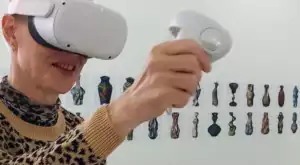
Read more: Sustainable urban Planning, Designing cities for great future
Overcoming Practical Limitations:
1.Cost-Effective Practical Simulations:
Reduced Expenses: VR provides a more affordable option to conventional practical training by doing away with the requirement for costly materials and equipment.
Safety and Risk Mitigation: VR reduces potential risks by enabling trainees to perform intricate processes in a secure virtual environment in industries like medical or aviation.
2.Unlimited Learning Resources:
Diverse Content Library: VR opens up a world of virtual resources, ranging from art museums to space, improving the curriculum and enhancing learning opportunities.
Endless Exploration: With so much virtual content available, students can learn more about a variety of topics in-depth and broadly, which improves their overall educational experience.
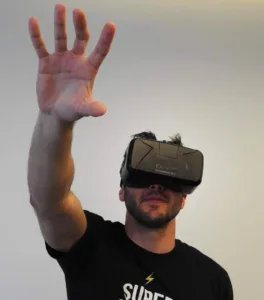
Challenges of Virtual Reality (VR):
Virtual reality (VR) has come a long way, but there are still a number of issues that need to be resolved before it can be widely used and easily incorporated into a variety of businesses. The following are some of the major issues with virtual reality:
1.Cost and Accessibility:
High Initial Investment: Because VR technology and software might be pricey, it may not be as readily available to smaller businesses and individuals.
Upkeep Costs: VR technology’s constant developments can call for periodic upgrades, raising the overall cost.
2.Motion Sickness and Discomfort:
Simulation Sickness: Due to an imbalance between visual cues and bodily movement, some users may feel queasy or uncomfortable, especially during sessions involving sudden or rapid motion.
3.Content Development:
Resource-Intensive Creation: It takes specialized knowledge, software, and equipment to create high-quality VR content, which can be time- and resource-consuming for creators.
Content Diversity: To satisfy varied use cases and interests, a broader variety of material from different industries is required.
4.Technological Limitations:
Limited Field of View (FOV): The immersive experience can be constrained by the limited FOV of many VR headsets.
Resolution and Clarity: Some VR displays still struggle to provide high-resolution images that are as clear as real-world objects.
5.User Interface and Interaction:
Intuitive Controls: It can be challenging to create user interfaces for virtual environments that are both user-friendly and effective, especially when dealing with challenging tasks or simulations.
Haptic Feedback: Technically, it’s still difficult to produce touch sensations that are realistic.
6.Hardware Constraints:
Comfort and Weight: Long-term use of VR headsets necessitates comfort, hence lighter, more ergonomic designs are needed.
Wireless Technology: The freedom of mobility for VR users would be significantly improved by reducing or eliminating the requirement for wires and cables.
7.Social and Ethical Concerns:
Privacy and Security: Data security and privacy issues grow more important as VR experiences become more interactive and social.
Isolation: If prolonged VR use is not counterbalanced by social connections in the real world, it may result in social isolation.
8.Health and Safety:
Physical Space Requirements: It can be difficult to provide a secure physical location for VR use, especially in congested or small spaces.
Ergonomics: VR use for extended periods of time can cause physical discomfort, such as eye strain and musculoskeletal problems.
9.Standardization and Compatibility:
Fragmented Ecosystem: To ensure compatibility across various VR devices and apps, more standardized hardware specs and development platforms are required.
10.Education and Training:
Training and Familiarization: Users, particularly in professional contexts, could need training to use VR systems efficiently, which could raise the overall implementation costs.
11.Content Regulation:
Content Quality and Standards: It is essential to establish standards for proper use cases and content quality, especially in sensitive or instructional settings.
12.Ethical Dilemmas:
Virtual Reality Ethics: Ethical conundrums including problems like addiction, violence, and exposure to sensitive materials may materialize as VR grows more realistic and immersive.
(Collaboration between technology developers, content providers, regulators, and end users is necessary to address these issues. Many of these issues will probably be resolved as technology develops and best practices become more widely accepted, creating new opportunities for the broad use of virtual reality.)
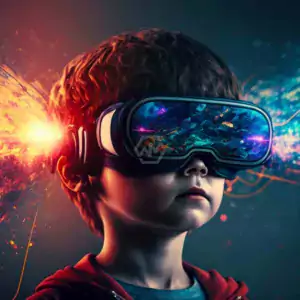
List of 10 companies that are working in Virtual Reality sector:
Meta Platforms, Inc. (formerly Facebook):
Through its subsidiary Oculus, Meta, formerly known as Facebook, is a leader in virtual reality technology. The Quest series and Oculus Rift are popular VR headsets. The business is currently advancing VR technologies for video games and interpersonal interactions.
SONY:
The PlayStation VR from Sony has been a major player in the VR gaming industry. As a result of the PlayStation VR’s popularity, Sony has been funding virtual reality research.
HTC Corporation:
Consumers and experts alike favor HTC’s Vive series of virtual reality headsets, especially the HTC Vive and Vive Pro. They are renowned for providing immersive experiences and excellent tracking.
Valve Corporation:
A significant player in the VR market, Valve is renowned for working with HTC to create the HTC Vive. They have also released their own VR hardware, such as the highly praised Valve Index with its cutting-edge tracking technology.
Microsoft:
Although Microsoft’s HoloLens is more of an augmented reality (AR) gadget, its influence on the larger XR (extended reality) space makes it noteworthy. The Mixed Reality platform from Microsoft mixes AR and VR experiences.
Google (Alphabet Inc.):
With tools like Google Cardboard and Google Daydream, Google has made major breakthroughs in the field of virtual reality. These are basic VR platforms that make use of smartphones as displays.
Pico Interactive:
The company Pico Interactive specializes in standalone VR headsets. They create standalone VR systems that don’t need a computer or additional sensors.
Varjo:
Varjo specializes in high-end virtual reality (VR) and mixed reality (MR) equipment for business use. They are renowned for their incredibly high-resolution screens, which are intended for activities like training, research, and simulation.
Epic Games:
Despite being primarily a game development firm, Epic Games’ Unreal Engine has been crucial in advancing VR technology. The engine is frequently used to produce VR content and has assisted in the development of VR technology.
Magic Leap:
A startup called Magic Leap specializes in mixed reality technology, which combines virtual and actual reality. The Magic Leap One, their product, attempts to produce immersive experiences that seamlessly blend with the actual world.
Note:Please be aware that the virtual reality (VR) market is dynamic and that new players or current ones may have changed their focus.
Read more: Impact of AI on the job market in 2030
Conclusion:
the adoption of virtual reality in the classroom has enormous potential to transform the learning process. VR has the potential to engage pupils in ways that were previously unthinkable because to its capacity to build immersive and interactive worlds. In order to fully utilize the potential of VR in influencing the future of education, educators, policymakers, and innovators must collaborate as technology develops and becomes more widely available. By doing this, we can develop a more diverse, lively, and productive learning environment for future generations.
That’s for now about Virtual Reality. Thanks for reading at our website. If you find some changes in above researched information then please don’t hesitate to reach out at: thehappeningworld44@gmail.com
If you like this article, please share it and you can also suggest us about more topics that we can cover in our upcoming articles at our website.
See you again, Thanks!!!
